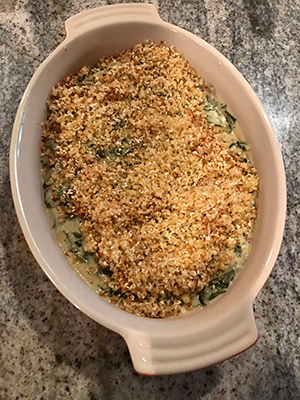Cooking with collards
Published 2:12 am Saturday, November 11, 2017
While reading the new issue of ‘Southern Living’ this week I found that according to a 2014 study of the nutritional density of powerhouse fruits and vegetables conducted by the Centers for Disease Control and Prevention, collards ranked number 10 in nutritional value and kale number 15. Kale was the hot new thing for several years and restaurant menus featured the vegetable in the form of snacks, salads, smoothies and soups. Kale was sexy; kale was the beauty queen of brassicas.
Why haven’t collards greens gotten kale’s celebrity? We in the south know that collards are good, but the rest of America doesn’t recognize them except as a green drowned in pork fat. As Southerners moved away from their native region or improved their financial situations, many left behind down-home cooking style.
Researchers believe the greens descended from wild cabbages grown in Asia in prehistoric times, then spread throughout Europe; the Greeks and Romans were big fans. Nonetheless, Southerners claim them as their own. The West Africans, Native Americans, and Europeans living throughout the South in the seventeenth century shared an appetite for the greens and collards grew easily here, in gardens high and low, from Monticello to the quarters of the enslaved peoples providing essential nutrients like iron and vitamins A and C in the region’s mild winter.
In thinking of my sides for Thanksgiving, collards were high on my list. They are at their best after a frost which comes around Thanksgiving. So kale move over. Anything you can do, collards can do better!!
This dish is easy to prepare and delicious. We made several meals out of it and I even cut the recipe in half. Serve it up for Thanksgiving.
From ‘The Local Palate’ November 2017.
Creamed Collard Greens with Breadcrumbs and Benne Seeds
Serves 8
½ pound slab bacon, diced
1 large Spanish onion, minced
4 pounds collard greens, washed, de-stemmed, and thinly sliced
4 cups chicken stock
½ pound butter, plus 4 tablespoons
1 cup flour
2 cups whole milk
2 cups heavy cream
1 teaspoon ground nutmeg
½ teaspoon cayenne pepper
1 cup panko
½ cup benne seeds
Salt and pepper to taste
In a large dutch oven over medium-high heat, cook bacon until crispy. Drain fat and return to pan. Add onion and sweat until translucent. Add collard greens and sauté until bright green. Pour in stock and reduce to a simmer.
While greens are cooking, melt ½ pound butter in a saucepot over medium-high heat until frothy, then whisk in flour to make a roux. Whisk in milk, cream, nutmeg, and cayenne and bring to a boil (the mixture will be quite thick). Add the béchamel to the greens and incorporate fully. Continue to simmer until tender, about 15-20 minutes.
In sauté pan over high heat, melt remaining butter. Add panko and benne seeds and cook, stirring constantly, until evenly golden brown. Season with salt to taste. When the greens are tender, season with salt and pepper to taste, transfer to a serving dish, and top with the breadcrumb mixture. Serve immediately.
You can easily buy collards here in the deep South, but you can easily grow your own to harvest when the leaves are smaller and tenderer. Buy plants and start about mid to late October. I started some with an earlier cool snap and they were shredded by tiny caterpillars. The ones started later have had less of a problem. They should provide us with greens through the winter and on into the spring. Starting plants in the spring I think is too late. You can easily start plants even now. Use compost when setting out and water in. You should be good to go. I had a great crop last year and the deer got in the garden and mowed all the fall garden to the ground. (I’ve fixed the fence.)
I also plant kale. You can easily mix kale, collards, turnip greens and/or mustard greens in the pot. I even throw in some leaves from the broccoli plants.






